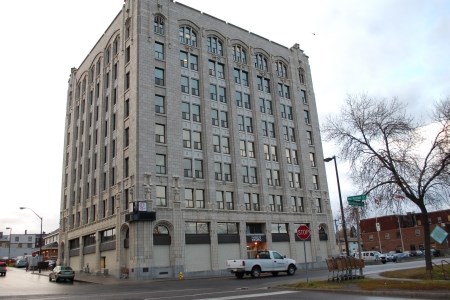Every morning when he goes to work, Steve Demmings can watch the sun peek its head out from behind the Sleeping Giant peninsula, and make its way slowly as it ascends over the north shore of Lake Superior. The view from the Thunder Bay Community Economic Development Commission’s (CEDC) boardroom is spectacular, as far as Demmings is concerned, and he is hoping more people will soon share his vision.
Demmings, the CEDC’s chief executive officer, is hoping to create a cluster of information and communications technology (ICT) businesses and organizations in the city-owned Whalen Building, located on Cumberland Street. The CEDC relocated to the second floor of the building in 2008 to demonstrate the potential of placement in the heritage building.
So far, Demmings has attracted Tornado Medical Systems, a medical imaging technology company, to the Whalen ICT Project. Tornado plans to move its head office onto the entire sixth floor of the landmark building from its current location on Munro Street next spring. Major renovations on the floor are currently underway.
Stefan Larson, Tornado’s CEO, says he is excited to be part of the CEDC’s vision for the Whalen, which will provide the company with a state-of-the-art facility for pre-clinical and clinical research and development. Larson estimates the company will employ about 50 professionals within the first two years, and that number is will likely grow.
A major part of Tornado’s focus as a company is turning ideas into “real-life value,” according to Larson.
“Our company was founded on new ideas,” he says. “A great idea, if not acted upon, is wasted potential. I see a lot of new ideas in Thunder Bay.”
Demmings says he hopes the Whalen Building will be one part of a larger revitalization of the city’s north end, which includes the city’s ongoing waterfront redevelopment. The historic section also includes a number of banks, churches, heritage buildings, and an entertainment district.
Demmings says his dream is to create an “active, flourishing downtown” in the north end.
“This whole area is a diamond in the rough,” he says. “It needs some polishing.”
The Northern Ontario Heritage Fund is providing $1 million for renovations to the Whalen, which was constructed in 1913, in the hopes that it will help attract new economic activity. Major renovations have been made in recent years to sign up more leaseholders. The city plans to attract more ICT-related companies into the building over the next three to four years.
“We want to bring back the original grandeur of the building,” says Demmings. “This building was built for lumber and grain barons. Now we want to build it for ICT barons.”
Demmings, who plans to launch a major marketing campaign to attract more leaseholders, says he hopes Tornado’s relocation will be a catalyst in helping the CEDC achieve its longer-term goals for the heritage building and its desire to create a diversified knowledge-based economy in Thunder Bay.
The CEDC undertook a labour pool analysis for the Whalen ICT Project in 2009. The analysis considered the number of graduates from Lakehead University and Confederation College to evaluate the potential of staffing the Whelan Building with ICT-related tenants over the next four years. The study estimates that an employer leasing space in the building could annually attract between 83 and 208 potential employees graduating with an ICT-related skill set from the local university and college.
The analysis concluded that Thunder Bay “can offer substantial potential labour for staffing the Whalen ICT project over a five-year period.”
The eight-storey building, which will celebrate its centennial in 2013, was named after James Whalen, a local businessman who wanted to develop the city into the “Chicago of the North.” He established several businesses and was instrumental in starting the city’s shipping industry with the Great Lakes Dredging Company.
Whalen later moved to the West Coast where he was president of several companies, including pulp and paper mills in Vancouver. Misfortune struck when Whalen lost his fortune after his pulp and paper company went bankrupt in 1925.
He died in 1929.
Designed by Montreal architects Brown and Vallance and built by Canadian Stewart Company Ltd., the building is known to locals as the Hydro Building.
But Demmings hopes to change that. He wants the building’s history to be reflected in its name.
Carved human faces, reflecting early settlers of the area, and other designs appear on the glazed terra cotta exterior of the building, and windows feature semi-circular decorated arches. The interior lobby and staircases are constructed of marble, and terra cotta carved designs can be seen on the walls and stair railings. Vault doors still exist within offices on each floor and have been refurbished to demonstrate their original look, while old carpeting has been removed to show off the marble flooring.
The building originally housed Port Arthur city hall offices, banks, offices, and Whalen’s business interests. It currently houses Thunder Bay Hydro, law offices, insurance companies and the District of Thunder Bay Social Services Administration Board (Ontario Works.)




